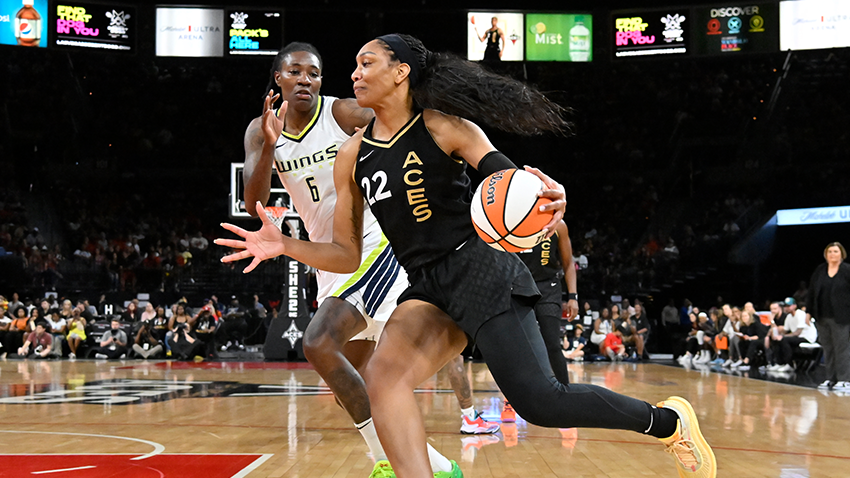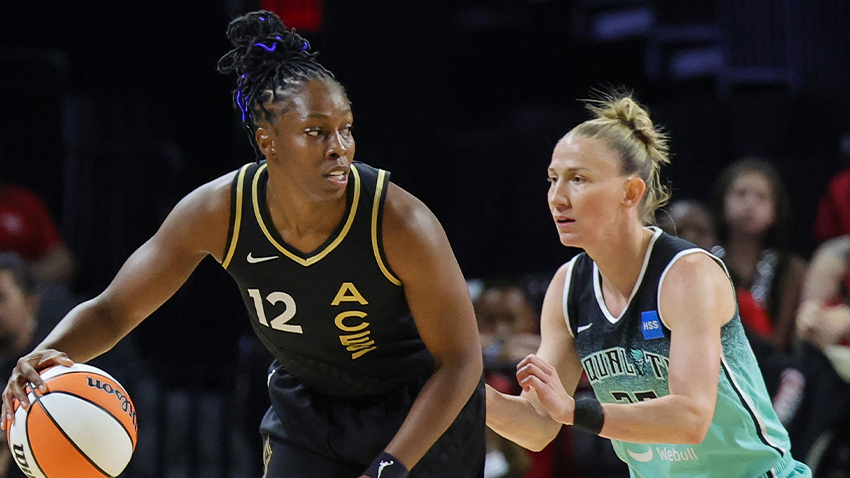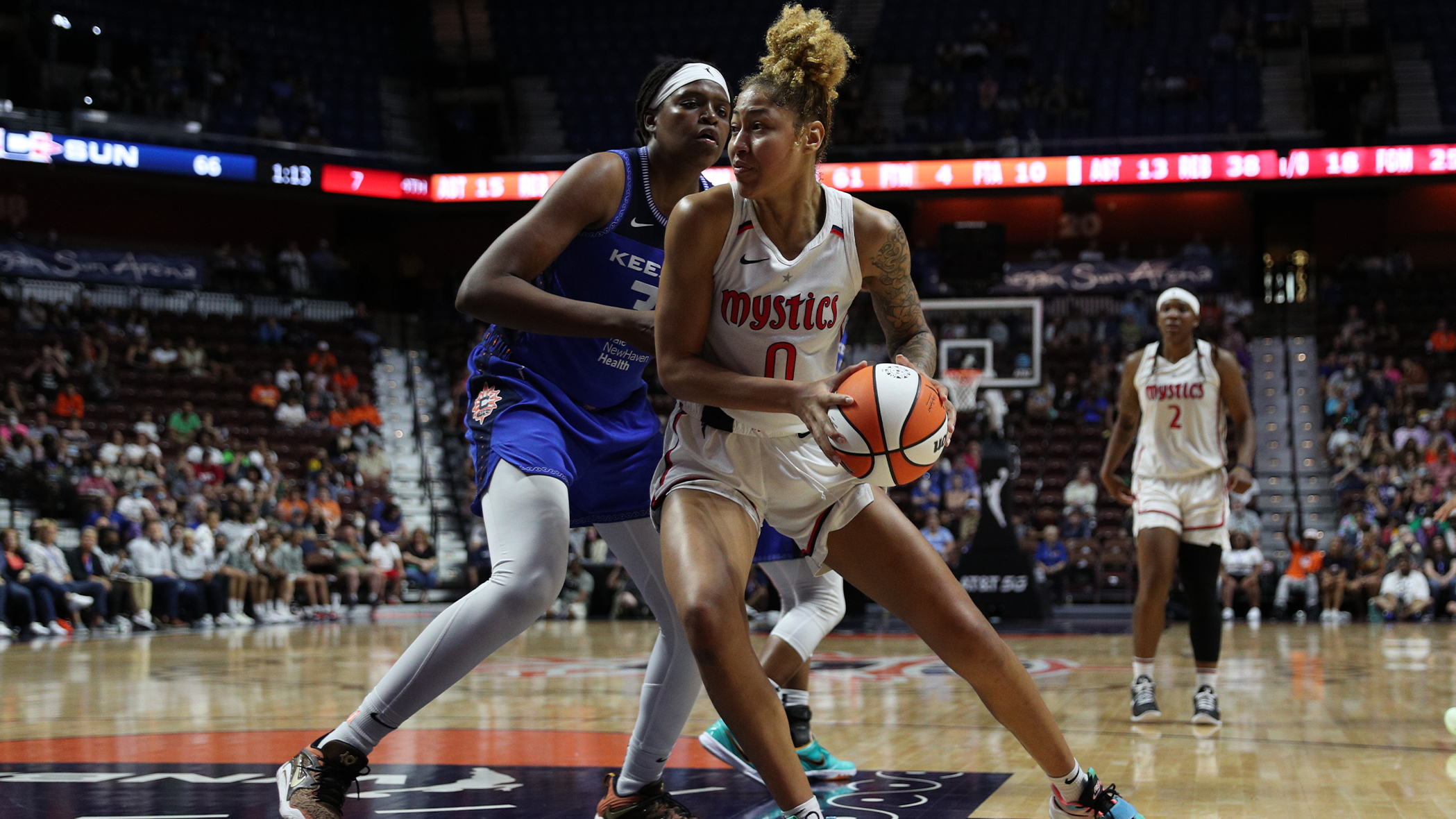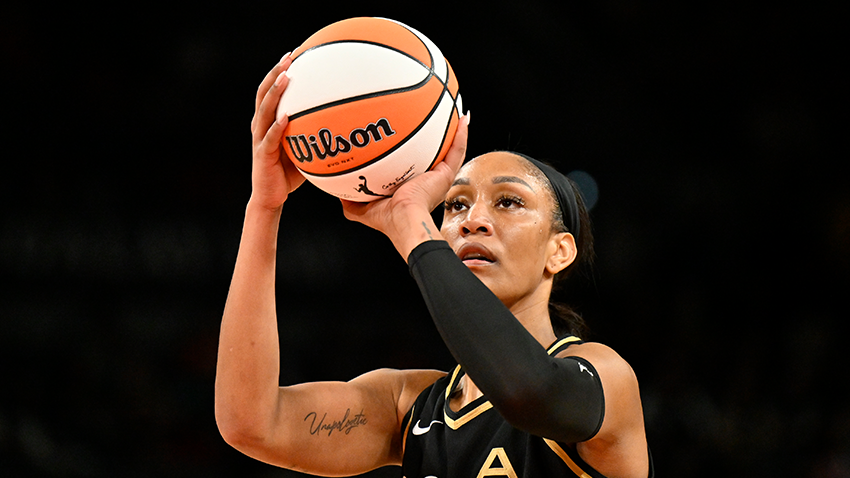Four of a Kind | A'ja Wilson and Chelsea Gray

Welcome to Four of a Kind, a two-part series detailing how the core of the Las Vegas Aces grew into the dominant group we see today. Nekias Duncan and Mark Schindler each wrote about a pair of Aces, highlighting key growth areas for each player. Here’s Nekias on the dynamic duo of A’ja Wilson and Chelsea Gray.
CHELSEA GRAY FLIPPING THE SWITCH
When the Aces acquired Chelsea Gray ahead of the 2021 season, she was expected to be equal parts stabilizing and exhilarating. Her blend of playmaking and timely shot-making was meant to raise the floor and ceiling of a group headlined by a trio of former first-overall picks – A’ja Wilson, Kelsey Plum, and Jackie Young.
It’s hard to separate Gray from her offensive impact. Her no-look lasers are, as head coach Becky Hammon put it earlier this season, “liable to hit you in the head” if players aren’t on high alert. Wilson is rarely surprised by what Gray pulls off, noting that the flashy passes that “wow” us during games are tossed regularly during practice. And if that wasn’t enough, her mix of pull-up jumpers, shifty drives, and post buckets consistently throw opponents for a loop. Ask, well, anyone who faced her during last year’s title run.
That stuff is loud and obvious to see. What’s gone under the radar is Gray’s importance to the Aces’ defense.
From a schematic standpoint, there aren’t many teams, if any, more diverse than the Aces. They will toggle between switching and blitzing. They will not only toss out a zone defense but also different types of zone defenses. You have to be locked in to defend at a high level in the WNBA; you especially have to be locked in when playing defense for the Aces because you never know what coverage will be called.
“A lot of this is their internal fortitude, understanding what we’re doing,” Hammon says.
“We have a year under our belt together; if I say a certain term, they know exactly what kind of picture I’m trying to paint for them.”
Gray notes that the Aces defend in a “completely different” way under Hammon than they did under previous head coach Bill Laimbeer. That change in philosophy has led to more freedom but also required a shift in preparation from Gray.
“The way I trained became a little different so I could sustain for longer periods of time. Being able to withstand hits, box-outs, and different matchups.”
Gray’s ability to adapt has gone a long way towards unlocking that level of versatility. The Aces couldn’t switch as effectively as they do without Gray’s ability (and willingness) to defend bigger players.
“You run it back to our Finals matchup against Connecticut last year, she played the post,” Hammon said recently.
“And that’s a handful when you have [Brionna] Jones down there, JJ [Jonquel Jones] down there, AT [Alyssa Thomas] down there. Chelsea’s going to beat you with her mind, angles, and her hands. She’s got great hands and anticipation.”
Because Gray has proven capable of defending bigger players, the Aces can afford to lean on their smaller lineups. That means maximum spacing on the offensive end – the last thing opponents want to deal with, considering how much offensive star power the Aces have.
The unit they closed out Game 4 of the 2022 Finals with – Gray, Plum, Riquna Williams, Young, and Wilson – logged just 63 minutes last season, out-scoring opponents by 61 points in that timeframe. This year’s primary small-ball unit, with Sixth Player of the Year winner Alysha Clark replacing Williams, has logged 311 minutes and counting, winning those minutes by 142 points.
It’s worth noting that while both groups won their minutes handily, it looked much different. Last year’s unit posted a typo-worthy 149.3 offensive rating but also allowed teams to score at an elite rate (122.9). This year’s group still scored at a high level (118.1 offensive rating) but complemented that offense with an airtight defense (99.1 defensive rating).
That isn’t all on Gray, but her presence and impact play a significant role in Hammon’s confidence going small. It also helps that Gray is making things happen. She’s drawn 13 charges in the Hammon Era, tops in the WNBA over that stretch. She set a career-high in blocks this season (25) and has already tied last postseason’s total (6) through five postseason games.
In short, the Point Gawd has also done her part to take enemy points off the table.
A’JA WILSON’S OWNERSHIP OF SPACE
Naturally, you can’t talk about two-way impact without talking about Wilson. It’s hard to narrow the scope of what Wilson’s done this year; she scored at a career-high rate, on career-best efficiency, while racking up her second Defensive Player of the Year award in a row. If there’s a theme for Wilson this season, it’s how she navigates space.
Wilson was an absolute terror from inside the arc. She drilled an absurd 53.4% of her mid-range jumpers, the highest mark in the league among 25 players who took at least 75 of them. Add in a 71% clip on shots at the rim and 7.2 free throw attempts (2nd in the league). It’s fair to say nobody dominated inside quite like Wilson did.
Her improved comfort as a face-up threat pops when you turn on an Aces game now, a shift Wilson attributes to defenses dialing in on her back-to-the-basket moves earlier in her career. Entering her third season, Wilson set out to establish her face-up game and elbow jumper as her “bread and butter.”
“When you look at the greats – KD [Kevin Durant], Kobe [Bryant], MJ [Michael Jordan] – they all get to their spots. It does not matter who’s guarding them; they’re going to get to their spot, and you know what would happen then. I wanted to create a spot where I knew ‘it’s go-time whenever I got there.”
Her offseason regimen included gamified workouts to prevent boredom. She worked on zero-dribble and one-dribble pull-ups to simulate game situations. It didn’t take long for Wilson’s mid-range attempts to rise. After taking 96 in Year 2 (2019), that number shot up to 122 in 2020, then a career-high 136 in 2021, a slight dip to 122 again last season before rising back to 133 this season.
As teams attempted to shrink the floor against Wilson with more active help defenders, the Aces countered this year by running Wilson off of screens. They’ve found recent success running her off a pair of staggered screens, something Wilson enjoys.
“I love coming off those staggers because I get to really analyze the defense and see it. A lot of times, the defense is behind me, so I don’t get to really see it until I catch the ball. When you’re in a stagger, I can see the defense in front of me. I can see what they’re doing, so I’ll know what I need to do – whether that’s popping out for three or curling inside. It’s allowed me to tap into the guard side of my brain, and I like that.”
While Wilson has found new ways to carve out space offensively, she’s been just as impactful taking space away on the defensive end. Wilson anchored the league’s best defense, swatting away 2.2 shots, racking up 1.4 steals, and nearly matching a career-high in defensive rebounds (7.5).
Her ground coverage as a weak-side rim protector has popped alongside Candace Parker or Kiah Stokes. When operating as the lone big, she’s toggled between switching at a higher rate or having more responsibility when defending ball screens, knowing that the help behind her will be smaller – or nonexistent.
This version of Wilson is incredible – back-to-back Defensive Player of the Year awards speak for themselves – but it wasn’t the expected outcome. Wilson and her college head coach, Dawn Staley, have joked about Wilson’s improvement on that end.
Wilson was straightforward when asked to reflect on the rookie version of herself and her mindset entering the league: “I didn’t want to get bullied!”
“To this day, I’m like, ‘I’m not gonna let anyone Lil Bro me.’ When people duck their shoulder into me, I’m like, ‘Alright, hold up because you’re trying to test my weight room.'”
Dealing with beefier centers was a challenge for Wilson early on, with her highlighting the Minnesota Lynx’s frontcourt of Rebekkah Brunson and Sylvia Fowles. But those early battles sparked Wilson to work on her footwork and shiftiness.
“My thing turned into, ‘If they can’t find your body, they can’t bully you.”
Now, Wilson is one of the toughest bigs to get a hit on. Hammon has compared Wilson to a cat on multiple occasions this season due to her ability to avoid contact down low. Many of Wilson’s steals have come from opposing bigs trying to seal her in the paint, only for Wilson to slither around and get deflections.
Wilson has transformed from a low-post star with shot-blocking chops to a versatile, 2.5-level scorer and legitimate defensive anchor. She’s the foundation of one of the best basketball teams we’ve ever seen.
WNBA reporter Nekias Duncan writes columns on WNBA.com throughout the season and can be reached on Twitter at @NekiasNBA. The views on this page do not necessarily reflect the views of the WNBA or its clubs.



,xPosition=.5,yPosition=.5)
,xPosition=.5,yPosition=.5)
,xPosition=.5,yPosition=.5)
,xPosition=.5,yPosition=.5)